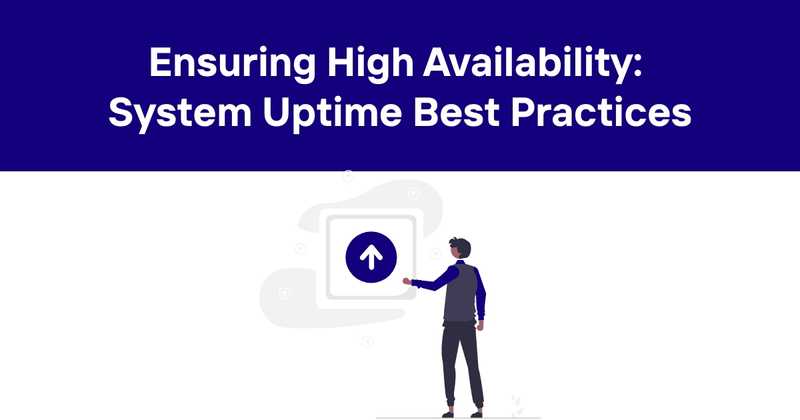Ensuring High Availability: System Uptime Best Practices
Table of Contents
- Introduction
- Understanding Uptime and Its Importance
- Common Causes of Downtime
- Key Strategies for Improving Uptime
- Measuring and Analyzing Uptime
- Emerging Technologies for Uptime Optimization
- Best Practices for Maintaining High Uptime
- The Role of Odown in Maximizing Uptime
Introduction
Let's face it - keeping systems up and running 24/7 is no walk in the park. As a developer, I've had my fair share of 3 AM wake-up calls to deal with unexpected outages. There's nothing quite like the panic of realizing your critical systems are down and users are impacted.
But here's the thing - downtime doesn't have to be a regular part of life. With the right strategies and tools, it's possible to dramatically improve uptime and keep your systems humming along smoothly. In this article, we'll dive into the nitty-gritty details of how to maximize uptime and minimize those dreaded outages.
We'll cover everything from the basics of what uptime really means to advanced techniques for optimizing availability. I'll share battle-tested strategies I've used in the trenches, emerging technologies to keep an eye on, and best practices you can implement today. By the end, you'll have a comprehensive playbook for taking your uptime to the next level.
So grab a coffee (you'll need it), and let's get started on the path to bulletproof uptime. Your future self will thank you when those late night emergencies become a thing of the past.
Understanding Uptime and Its Importance
Before we dive into the how, let's take a step back and look at the what and why of uptime.
At its core, uptime refers to the amount of time a system or service is operational and available for use. It's typically measured as a percentage over a given time period. For example, 99.9% uptime (also known as "three nines") means a system is operational 99.9% of the time.
Here's a handy table breaking down common uptime percentages and what they mean in terms of actual downtime:
| Uptime Percentage | Downtime per Year | Downtime per Month | Downtime per Week |
|---|---|---|---|
| 99% | 3.65 days | 7.20 hours | 1.68 hours |
| 99.9% | 8.76 hours | 43.8 minutes | 10.1 minutes |
| 99.99% | 52.56 minutes | 4.38 minutes | 1.01 minutes |
| 99.999% | 5.26 minutes | 25.9 seconds | 6.05 seconds |
As you can see, even small improvements in uptime percentage can have a big impact on actual system availability.
So why does uptime matter so much? Well, for starters:
-
User Experience: Nothing frustrates users more than trying to access a service that's down. High uptime means happy users.
-
Revenue Protection: For many businesses, downtime directly translates to lost revenue. Every minute of downtime could mean thousands in lost sales.
-
Reputation: Frequent outages can severely damage your brand's reputation and erode user trust.
-
Productivity: Internal systems that go down can grind work to a halt, impacting employee productivity.
-
Compliance: Many industries have strict uptime requirements that companies must meet for regulatory compliance.
The bottom line? Uptime isn't just a technical metric - it has real-world impacts on your business's bottom line and long-term success.
Common Causes of Downtime
Now that we understand why uptime matters, let's look at what typically causes systems to go down. In my experience, these are some of the most common culprits:
-
Hardware Failures: From server crashes to network equipment malfunctions, hardware issues are a leading cause of downtime.
-
Software Bugs: Poorly tested code, compatibility issues, or unforeseen edge cases can all lead to software-related outages.
-
Human Error: We're all human, and mistakes happen. Misconfigurations, accidental deletions, or other human errors often cause downtime.
-
Capacity Issues: Unexpected traffic spikes or resource constraints can overload systems and cause them to fail.
-
Security Incidents: Cyber attacks like DDoS attacks or data breaches can take systems offline.
-
Power Outages: Loss of power to critical infrastructure is a common cause of downtime, especially for on-premises systems.
-
Natural Disasters: Floods, fires, earthquakes and other natural events can cause extended outages.
-
Planned Maintenance: While usually controlled, maintenance windows still contribute to overall downtime.
-
Third-Party Dependencies: Issues with external services your system relies on can cascade into downtime for your own services.
-
Network Issues: From ISP outages to DNS problems, network-related issues are a frequent source of downtime.
Understanding these common causes is the first step in developing strategies to prevent and mitigate them. In the next section, we'll dive into specific techniques for improving uptime across all these areas.
Key Strategies for Improving Uptime
Alright, now we're getting to the good stuff. Let's roll up our sleeves and dig into the concrete strategies you can use to boost your uptime. I've broken these down into five key areas:
Implementing Redundancy
The core principle here is simple: have backups for everything. Some key ways to build redundancy into your systems:
- Use load balancers to distribute traffic across multiple servers
- Implement failover systems that can take over if primary systems go down
- Utilize multiple data centers in different geographic regions
- Use redundant network connections and power supplies
- Implement RAID for data storage redundancy
One caveat though - redundancy adds complexity. Make sure you have proper monitoring and failover testing in place, or you might end up with cascading failures across redundant systems. Not fun, trust me.
Proactive Monitoring and Maintenance
You can't fix what you don't know about. Proactive monitoring is crucial for catching issues before they cause downtime:
- Use comprehensive monitoring tools to track system health, performance, and resource utilization
- Set up alerts for key metrics and potential failure indicators
- Implement log analysis to catch error trends early
- Conduct regular security scans and penetration testing
- Perform preventative maintenance like regular software updates and hardware replacements
The goal is to catch and address potential issues before they impact users. It's like changing your car's oil regularly instead of waiting for the engine to seize up.
Disaster Recovery Planning
Even with the best prevention, stuff happens. Having a solid disaster recovery plan is crucial:
- Develop and regularly test a detailed disaster recovery plan
- Implement automated backups and ensure they're stored securely off-site
- Have clear procedures for different types of outages (hardware failure, network issues, etc.)
- Maintain up-to-date documentation on system architecture and recovery procedures
- Conduct regular disaster recovery drills to ensure your team is prepared
A good disaster recovery plan is like a fire extinguisher - you hope you never need it, but you'll be really glad you have it if you do.
Optimizing Infrastructure
Sometimes improving uptime is about working smarter, not harder:
- Use auto-scaling to handle traffic spikes without overprovisioning
- Implement caching strategies to reduce load on backend systems
- Optimize database queries and indexes for better performance
- Use content delivery networks (CDNs) to distribute static content
- Implement circuit breakers to prevent cascading failures
These optimizations can help your systems handle higher loads more gracefully, reducing the chance of outages due to capacity issues.
Automating Processes
Human error is a leading cause of downtime. Automation can help reduce these risks:
- Use infrastructure-as-code to manage and version system configurations
- Implement automated testing and deployment pipelines
- Use chaos engineering tools to automatically test system resilience
- Automate routine maintenance tasks like log rotation and backups
- Implement automated failover and recovery processes where possible
The less manual intervention required in your systems, the less chance there is for human error to creep in.
Measuring and Analyzing Uptime
You can't improve what you don't measure. Accurate uptime measurement and analysis is crucial for ongoing improvement:
- Define clear uptime metrics and SLAs
- Use monitoring tools to track uptime across all systems
- Analyze patterns in downtime occurrences
- Conduct thorough post-mortems after any significant outage
- Track mean time between failures (MTBF) and mean time to recovery (MTTR)
- Use uptime data to identify areas for improvement and prioritize investments
Remember, the goal isn't just to track uptime, but to use that data to drive continuous improvement in your systems and processes.
Emerging Technologies for Uptime Optimization
The world of tech never stands still, and there are some exciting new technologies that promise to help improve uptime even further:
-
AI and Machine Learning: These technologies are being used to predict potential failures before they happen, allowing for proactive intervention.
-
Serverless Architecture: By abstracting away infrastructure management, serverless can reduce many common causes of downtime.
-
Edge Computing: Moving processing closer to the end user can improve resilience and reduce the impact of central system failures.
-
Blockchain: While still emerging, blockchain technology could provide new ways to ensure data integrity and system availability.
-
5G Networks: The increased speed and reduced latency of 5G could enable new architectures for improving uptime.
It's worth keeping an eye on these technologies and considering how they might fit into your uptime strategy as they mature.
Best Practices for Maintaining High Uptime
Before we wrap up, let's recap some key best practices for maintaining high uptime:
-
Design for failure: Assume things will go wrong and build systems that can gracefully handle failures.
-
Embrace DevOps culture: Break down silos between development and operations to improve communication and reduce errors.
-
Implement robust change management: Uncontrolled changes are a major source of downtime. Have clear processes for managing and testing changes.
-
Invest in training: Ensure your team has the skills and knowledge to effectively manage and troubleshoot your systems.
-
Learn from incidents: Conduct thorough post-mortems after any downtime and use those lessons to improve your systems and processes.
-
Stay current: Keep systems updated and patched to avoid security vulnerabilities and compatibility issues.
-
Monitor proactively: Don't wait for users to report issues. Use comprehensive monitoring to catch problems early.
-
Test regularly: Conduct regular load testing, failover testing, and disaster recovery drills.
-
Document everything: Clear, up-to-date documentation is crucial for effective incident response and knowledge sharing.
-
Continuously improve: Treat uptime as an ongoing process of improvement, not a one-time goal.
Remember, maintaining high uptime is an ongoing process. It requires constant vigilance, continuous learning, and a commitment to improvement.
The Role of Odown in Maximizing Uptime
Now, I can't wrap up this article without mentioning a tool that can be incredibly helpful in your quest for improved uptime: Odown.
Odown is a comprehensive website and API monitoring tool that can play a crucial role in your uptime strategy. Here's how:
-
Website and API Monitoring: Odown provides real-time monitoring of your websites and APIs, alerting you to any issues before they impact users.
-
SSL Certificate Monitoring: With Odown's SSL monitoring tool, you can avoid the embarrassment (and security risks) of expired SSL certificates.
-
Public Status Pages: Odown allows you to create public status pages, improving transparency and reducing support load during outages.
-
Detailed Reporting: Odown provides comprehensive uptime reports, helping you track your uptime over time and identify areas for improvement.
-
Integrations: Odown integrates with popular tools like Slack and PagerDuty, ensuring your team is always in the loop about potential issues.
By incorporating Odown into your uptime strategy, you can catch issues early, communicate effectively with users, and gain valuable insights to drive ongoing improvements.
In conclusion, improving uptime is a complex but crucial task for any development team. By understanding the causes of downtime, implementing robust strategies for prevention and recovery, and leveraging tools like Odown, you can significantly boost your uptime and provide a better experience for your users.
Remember, the journey to improved uptime is ongoing. Keep learning, keep improving, and don't be afraid to leverage new technologies and tools as they emerge. Your users (and your sleep schedule) will thank you.



